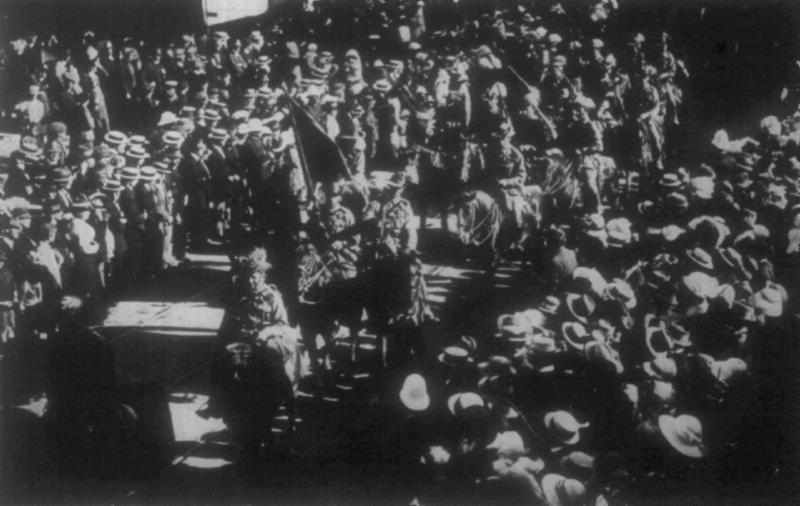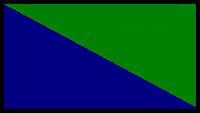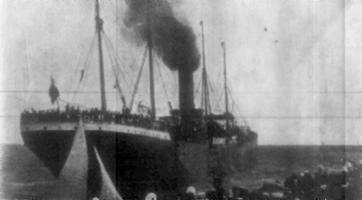Topic: AIF - 4B - 11 LHR
11th LHR, AIF
11th Australian Light Horse Regiment
Outline

11th Light Horsemen parading through Brisbane, Queensland, June 1915.
Formation
The 11th Light Horse Regiment was formed as part of the 4th Australian Light Horse Brigade, 1915 , 4th Contingent and attached to the Australian Division. The 11th Light Horse Regiment was a composite regiment with two squadrons made up by recruits from the 1st Military District which incorporated all of Queensland, Darwin and Northern New South Wales while the last squadron, "C" Squadron was composed of men from the 4th Military District [South Australia and the Broken Hill region of New South Wales]. The 11th Light Horse Regiment was established at Enoggera Training Camp to the west of Brisbane, Queensland, at the end of March 1915. The South Australian members trained at Morphettville Race Track Training Camp to the west of Adelaide, South Australia.
"A" Squadron recruited from Queensland.
"B" Squadron recruited from Queensland.
"C" Squadron recruited from South Australia.
Training
[Click on page for larger version.]
The 11th Light Horse Regiment commenced training at Enoggera Training Camp to the west of Brisbane, Queensland, at the end of March 1915. The South Australian members trained at Morphettville Race Track Training Camp and later moving to the Mitcham Training Camp to the south of Adelaide, South Australia. On 2 May 1915, the 11th Light Horse Regiment came together at Fraser’s Paddock Camp, outside Brisbane, and trained as a single Regiment as opposed to previous composite regiments when training occurred at different locations.
Embarkation
Embarkation of the 11th Light Horse Regiment was accomplished in two groups using both the HMAT A7 Medic and HMAT A30 Borda from Brisbane, Queensland.
White Star Liner Medic leaving Port Melbourne, 28 October 1899
[See: His Majesty's Australian Transports [HMAT] Ships, A7.]
The 11th Light Horse Regiment Headquarters, Machine Gun Section, "A" and "C" Squadrons embarked on the HMAT A7 Medic from Brisbane, Queensland, 2 June 1915.
11th Light Horse Regiment "B" Squadron embarked on the HMAT A30 Borda from Brisbane, Queensland, 16 June 1915.
The 11th Light Horse Regiment sailed to Egypt and disembarked on 23 July 1915.
Colour Patch
Initially, the only colour separation of the various Australian mounted troops was by use of the pennant. The marker pennants were carried on poles to mark lines troop lines in camps in Egypt. They were not lance pennants as the Australian lancers had red over white pennants on their lances.

While this pennant was useful in distinguishing horse and troop lines, it failed to identify the individual with a unit. The AIF 1st Australian Division Standing Orders issued in December 1914 ordered the Australian Light Horse Regiments to wear a 4 inch wide [10.2cm] blue armband with the regiment name marked on the band in black lettering.
The earlier systems proved to be ineffective so to assist with identification of the men in the various units within the AIF, Divisional Order No 81 (A) Administration was issued at Mena on 8 March 1915 detailing the Colour Patch for the 11th Light Horse Regiment as others received their colours. The colour patch was made of cloth 1¼ inches wide and 2¾ inches long and worn on the sleeve one inch below the shoulder seam.


The reformed 11th Light Horse Regiment as part of the 4th Australian Light Horse Brigade, Australian Mounted Division, carried the blue Brigade colour as the lower triangle part of the colour patch, while the green unit colour was on the top. This is illustrated with the above presentation.
Aden
During the voyage to Egypt, the part of the 11th Light Horse Regiment travelling on the HMAT A7 Medic was diverted to Aden and landed on 12 July 1916 to bolster the defences of the British garrison which was under pressure from Yemeni tribesmen who were threatening an attack. By 18 July no attack had occurred and the threat diminished allowing the Regiment re-embarked to Egypt.
Gallipoli
As mounted troops, the Light Horse was considered to be unsuitable for work in Gallipoli. The mounted troops volunteered to operate as infantry. Because of the level of casualties at Gallipoli, the 11th Light Horse Regiment was broken up on 26 August 1915 with squadrons being allotted to other Regiments as reinforcements.
"A" Squadron became "D" Squadron, 2nd Australian Light Horse Regiment.
"B" Squadron became "D" Squadron, 5th Australian Light Horse Regiment.
"C" Squadron became "D" Squadron, 9th Australian Light Horse Regiment.
The various squadrons of the Regiment were deployed on primarily defensive activities throughout the stay at Gallipoli. The various squadrons of the 11th Light Horse Regiment left the peninsula during December 1915.
Defence of Egypt
After the return to Egypt, on 19 February 1916, the 11th Light Horse Regiment reformed and re-equipped. On 28 February 1916, the 11th Light Horse Regiment moved to the Suez Canal taking part in its defence. The work was hot and monotonous.
Sinai
After many months service in the Sinai, during September 1916 the 11th Light Horse Regiment was redesignated as the 1st Camel Regiment. The Regiment continued to see further service in the Sinai.
Palestine
During the reorganisation of the Light Horse Divisions, the Regiment resumed its old identity as the 11th Light Horse Regiment in February 1917. The 11th Light Horse Regiment became part of the 4th Light Horse Brigade in the Imperial Mounted Division and then Australian Mounted Division.
The 11th Light Horse Regiment took part in the Second Battle of Gaza on 19 April 1917 and suffered the heaviest casualties since Gallipoli.
The 11th Light Horse Regiment took part in the Battle of Beersheba but while they were part of the 4th Light Horse Brigade, the 11th Light Horse Regiment took no part in the charge.
On 7 November 1917, while charging at Tel el Sheria, a troop became separated from the squadron and was totally destroyed.
The 11th Light Horse Regiment and then took part in the follow up actions that lasted until early January 1918.
From this time onwards, for the next two months, the 11th Light Horse Regiment remained in continuous combat action until relieved for three months refit and training at Deir el Belah from early January 1918.In early April 1918, the 11th Light Horse Regiment moved into the Jordan Valley and took part in the invasion of Moab and took Es Salt during the action of 30 April – 4 May 1918. Unfortunately, due to a Turkish attack on the lines of communication which was being defended by 4th Light Horse Brigade, this raid nearly turned into a disaster where the Turkish forces almost cut off the Australian Mounted Division in the hills.
In a move that converted the Light Horse into full cavalry, the Australian Mounted Division was issued with swords during August and early September 1917. The Australian Mounted Division went to work training with swords and undertaking cavalry work.
On 19 September 1918 the Battle of Megiddo began. The infantry over ran the Turkish defensive trenches allowing the cavalry to debouch into the Turkish hinterland. The 11th Light Horse Regiment participated in the breakthrough which moved rapidly through the north of Palestine. At the end of the first week, it was obvious that the way to Damascus was open and so a second push occurred on the heels of the first assault. On 1 October 1918, Damascus was taken.
After a rest in Damascus, the 11th Light Horse Regiment moved towards Homs when the Turks surrendered on 30 October 1918.
Return to Australia
After the conclusion of hostilities, the 11th Light Horse Regiment was marked to return to Australia. Prior to that action, one of the saddest actions occurred for the Australian Lighthorsemen, they had to farewell their best friends, the horses. All the Light Horse unit horses' health was ascertained with the fit horses being transferred to the Indian Cavalry while those in poor condition were destroyed by the Veterinary units.
On 13 March 1919 the 11th Light Horse Regiment was deployed to assist in suppressing the Egyptian Uprising. When the revolt collapsed, the 11th Light Horse Regiment embarked on the 17 July 1919 for the long voyage to Australia where the unit was disbanded.
Commanding Officers
Lieutenant Colonel William Grant
Lieutenant Colonel John William Parsons
Lieutenant Colonel Percival John Bailey
Decorations earned by the 11th Light Horse Regiment
- 4 DSO - Distinguished Service Orders
- 9 MC & 1 Bar - Military Crosses
- 6 DCM - Distinguished Conduct Medals
- 13 MM- Military Medals
- 27 MID - Mentioned in Despatches
- 2 foreign awards
Campaigns
Gallipoli
- Sari Bair
- Gallipoli 1915-1916
Egypt
- Defence of Egypt
Palestine
- Second Battle of Gaza
- Third Battle of Gaza
- Beersheba
- El Mughar
- Nebi Samwill
- Jerusalem
- Jericho
- Es Salt
- Megiddo
- Sharon
- Palestine 1917-1918
Casualties suffered by the 11th Light Horse Regiment
- 95 killed
- 521 wounded
War Diary
The Australian War Memorial has put these on line and may be accessed here:
Embarkations:
The following list details all the embarkations in support of the 11th Light Horse Regiment, AIF, during the Great War. Each entry details to formation and the ships on which the units embarked with the date and place of embarkation. The detail of the formation is linked to a list of men who embarked upon that ship on the specific date.
| Regimental Headquarters Section | Brisbane, Queensland on board HMAT A7 Medic 2 June 1915 |
| "A" Squadron | Brisbane, Queensland on board HMAT A7 Medic 2 June 1915 |
| "B" Squadron | Brisbane, Queensland on board HMAT A30 Borda 16 June 1915 |
| "C" Squadron | Brisbane, Queensland on board HMAT A7 Medic 2 June 1915 |
| Machine Gun Section | Brisbane, Queensland on board HMAT A7 Medic 2 June 1915 |
| Brisbane, Queensland on board HMAT A7 Medic 2 June 1915 Adelaide, South Australia on board HMAT A30 Borda 23 June 1915 | |
| Sydney, New South Wales on board HMAT A9 Shropshire 20 August 1915 Adelaide, South Australia on board HMAT A61 Kanowna 24 June 1915 | |
| Brisbane, Queensland on board HMAT A55 Kyarra 16 August 1915 Adelaide, South Australia on board HMAT A15 Star Of England 21 September 1915 | |
| Brisbane, Queensland on board HMAT A1 Hymettus 17 September 1915 Adelaide, South Australia on board HMAT A15 Star Of England 21 September 1915 | |
| Brisbane, Queensland on board HMAT A69 Warilda 5 October 1915 Adelaide, South Australia on board HMAT A70 Ballarat 14 September 1915 | |
6th Reinforcements Mashobra Group 6th Reinforcements Benalla Group | Sydney, New South Wales on board HMAT A47 Mashobra 4 October 1915 Adelaide, South Australia on board HMAT A24 Benalla 27 October 1915 Sydney, New South Wales on board SS Hawkes Bay 23 October 1915 Melbourne, Victoria on board SS Hawkes Bay 26 October 1915 |
7th Reinforcements Hawkes Bay Group 7th Reinforcements Suffolk Group 7th Reinforcements Geelong Group | Sydney, New South Wales on board SS Hawkes Bay 23 October 1915 Sydney, New South Wales on board HMAT A23 Suffolk 30 November 1915 Adelaide, South Australia on board HMAT A2 Geelong 18 November 1915 |
| 8th Reinforcements | Sydney, New South Wales on board HMAT A10 Karoo 5 May 1916 |
| 9th Reinforcements | Brisbane, Queensland on board HMAT A49 Seang Choon 4 May 1916 |
| 10th Reinforcements | Sydney, New South Wales on board RMS Mongolia 8 July 1916 |
| 11th Reinforcements | Sydney, New South Wales on board RMS Malwa 22 July 1916 |
| 12th Reinforcements | Sydney, New South Wales on board RMS Mooltan 19 August 1916 |
| 13th Reinforcements | Melbourne, Victoria on board HMAT A65 Clan Macewen 9 October 1916 |
| 18th Reinforcements | Sydney, New South Wales on board HMAT A15 Port Sydney 9 May 1917 |
| 19th Reinforcements | Sydney, New South Wales on board HMAT A15 Port Sydney 9 May 1917 |
| 20th Reinforcements | Sydney, New South Wales on board HMAT A38 Ulysses 19 December 1917 |
See: Troop transport ships for information and photographs about the various ships employed in transporting the troops to Egypt.
Further Reading:
Battles where Australians fought, 1899-1920
Citation: 11th Australian Light Horse Regiment, AIF, Outline






